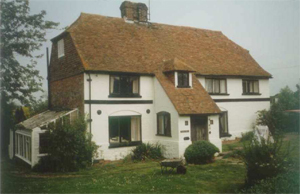Bridge House, Mersham, Kent. Archaeological Record in advance of and during dismantling
Oxford Archaeology (South), 2011. (updated 2017) https://doi.org/10.5284/1044794. How to cite using this DOI
Data copyright © High Speed 1 unless otherwise stated
This work is licensed under the ADS Terms of Use and Access.
Primary contact
Stuart
Foreman
Senior Project Manager
Oxford Archaeology (South)
Janus House
Osney Mead
Oxford
OX2 0ES
UK
Tel: 01865 263800
Fax: 01865 793496
Resource identifiers
- ADS Collection: 2347
- DOI:https://doi.org/10.5284/1044794
- How to cite using this DOI
Introduction

The Oxford Archaeological Unit (OAU) was commissioned by Balfour Beatty Major Project (BBMP) to carry out an archaeological investigation of the ground beneath the Grade II Listed building at Bridge House, Mersham, Kent (NGR: TR 0506 3932 ).The work was undertaken on behalf of Union Railways (South) Limited, as part of the recording of listed buildings in North East Kent, due to be demolished in advance of CTRL construction.
The investigation took place during the preparations for the removal of the house to an adjacent site 80m to the north-west. Due to the listed status of the building, it was decided to move the house, using a slide technique, rather than demolish it. OAU excavated several test pits within the house to determine the existence of early floor levels, and also carried out a watching brief on the trenches dug by hand by the engineers (Abbey Pynford) along the slide route and on the ring beam trenches under wall foundations.
Overall, the results of the below-ground archaeological investigations were disappointing and have added little to the understanding gleaned from the survey of the structure itself. The seven test pits excavated within the building aimed at establishing potential historical floor levels, revealed evidence of two former floor levels. In Test Pit 70 a possible clay floor was identified, and in Test Pit 80 a brick floor was revealed although neither produced dating evidence.
The archaeological watching brief revealed archaeological evidence suggesting a possible late 14th century occupation including post holes, pits and a gully (Phase I). In particular rooms 2 and 3 contained pottery from the 14th and 12th century, however the few sherds from the latter period are likely to be redeposited and there is no substantial evidence for activity prior to the late 12th century. Archaeological evidence from the late 17th century (Phase II) suggests Bridge House was built towards the end of the 17th Century. Phase 3 was a period of major change to the building, the main one was represented by a repair to the facade of the building with squared ragstone overlain by red brick, a south-west facing chimney and fireplace were also inserted. During the early 20th Century an extension was added to the house (Phase IV), a porch added in the later half of the 20th Century (Phase V) and in the late 20th Century a lean-to out building was constructed to the rear of the house.






